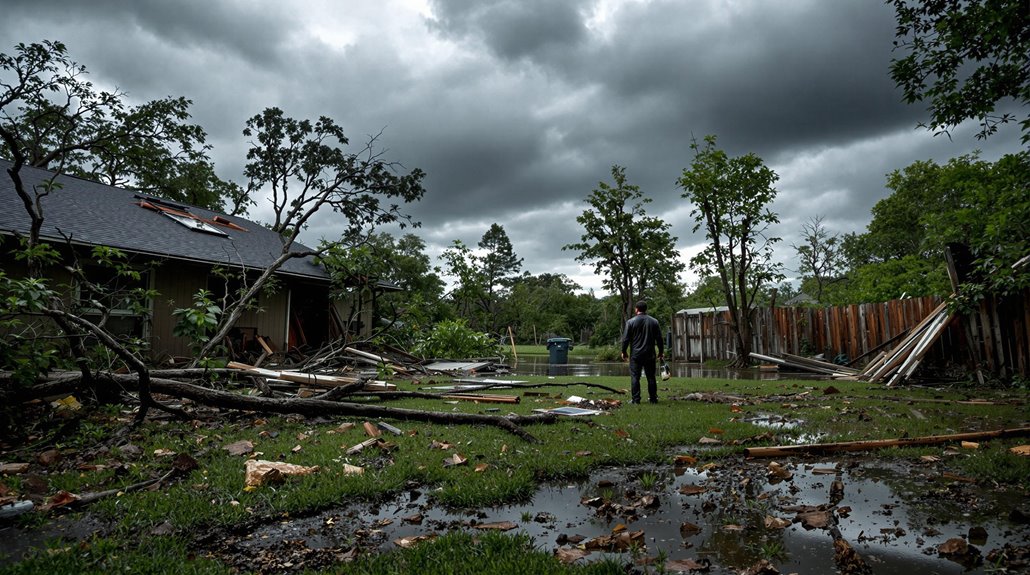After storm damage hits your property, prioritize your safety first. Check for hazards like downed power lines and structural instability. Document all damage with clear photos and an inventory of affected items. Contact your insurance company promptly and make sure you have all relevant details on hand. Make emergency repairs by securing windows and covering roof leaks to prevent further damage. Clear debris and monitor for additional risks around your home. Don't hesitate to seek professional help for assessments and repairs. Understanding these essential steps can greatly aid your recovery, allowing you to manage the aftermath with greater confidence.
Key Takeaways
- Ensure safety by checking for hazards like downed power lines and structural instability before entering the property.
- Document damage thoroughly with photos and videos, noting all affected areas and items.
- Contact your insurance company promptly to report damage and start the claims process.
- Make emergency repairs, such as covering broken windows and roof leaks, to prevent further damage.
- Clear debris from the property and avoid standing water to mitigate hazards and health risks.
Ensure Safety First
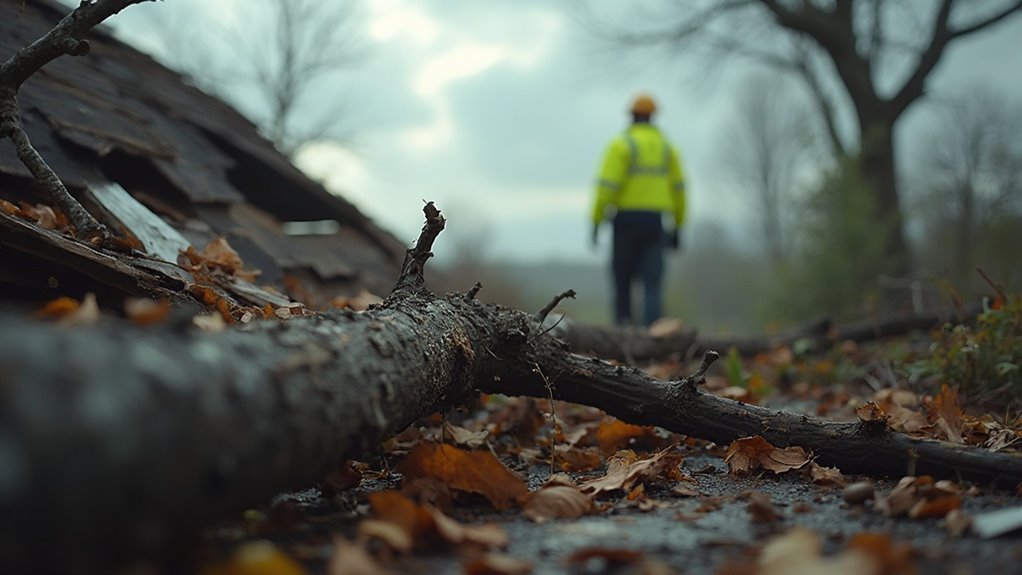
After a storm, your safety should be the top priority. Begin by checking local news outlets to assess the situation and determine if your area is safe. Hazard awareness is vital—watch for broken glass, exposed nails, and loose floorboards that can pose serious risks. Stay away from standing water, especially near downed power lines, as these can be life-threatening.
Assume that downed power lines are energized; maintain a distance of at least ten feet and alert the police and utility company immediately. Before inspecting your property, verify there's no risk of electrocution, and avoid using candles after dark.
Next, secure your property by removing debris from roofs and gutters to ensure proper drainage and direct water away. Prompt action is crucial, as emergency water removal can significantly reduce property damage. Board up broken windows and doors, and clear outdoor objects that could become projectiles in future winds. As part of your storm preparedness plan, gather emergency supplies like flashlights, batteries, and a first aid kit. Finally, establish a communication plan with family members and identify the safest areas in your home, such as a basement or windowless interior room. Prioritize these steps to protect yourself and your loved ones effectively.
Assess and Document Damage
Once you've guaranteed safety for yourself and your loved ones, it's time to assess the damage to your property. Start by inspecting the roof for missing shingles, holes, and broken gutters. Next, check the exterior walls for debris impacts and wind damage. Don't overlook windows and doors; look for broken glass and damaged frames. In your yard, survey for downed trees, branches, and any structural damage to outbuildings.
Documenting the damage is essential for effective disaster recovery. Take clear photos and videos from multiple angles to capture the full extent of the destruction. Create a written report detailing the nature and severity of the damage, and compile an inventory of damaged items along with their estimated values. Understanding water damage is crucial in determining the appropriate response and restoration methods.
Gather evidence of both structural and non-structural damage while noting any hazards, such as downed power lines. Collect receipts for any materials purchased for temporary repairs, which will be significant for your records. Finally, take immediate steps to mitigate further damage—cover broken windows and place tarps over roof leaks. This thorough assessment and documentation not only demonstrate your storm preparedness but likewise set you on a path toward recovery.
Contact Your Insurance Company

After evaluating and documenting the damage, it's essential to report it to your insurance company promptly. Understanding your coverage details will help you navigate the claims process more effectively, ensuring you receive the support you need. By following the insurer's instructions closely, you'll streamline the path toward recovery and compensation.
Report Damage Promptly
The urgency of reporting storm damage to your insurance company cannot be overstated; acting quickly can greatly impact your claim's success. Start the claim process by contacting your insurer as soon as it's safe. Here are crucial steps to follow:
- Use 24/7 hotlines if available.
- Prepare your policy number and damage details.
- Document all damage with photos and videos.
- Get a claim number for reference.
Once you've reported the damage, the insurance company will assign an adjuster for a thorough damage assessment. Make certain the adjuster can access all affected areas of your property, whether the visit is virtual or in person. Keep detailed records of their visit, noting date and observations.
Time is of the essence; delays can complicate your claim and may lead to denials. Stay proactive by submitting all documentation promptly, including any temporary repair receipts. Regularly update your insurer with new findings to guarantee a smooth claims process. By following these steps diligently, you position yourself for a more favorable outcome as you navigate the aftermath of the storm.
Understand Coverage Details
Understanding your insurance coverage details is crucial for effectively maneuvering the aftermath of storm damage. You need to familiarize yourself with the coverage limitations and exclusions overview in your policy. This knowledge empowers you to act decisively and effectively during claims.
| Coverage Type | Exclusions |
|---|---|
| Wind and hail damage | Flood damage (requires separate insurance) |
| Lightning strikes | Earthquake damage (separate insurance needed) |
| Water damage (storm-related) | Wear and tear (not covered) |
| Damage to additional structures | Pre-existing conditions (not covered) |
| Wildfire damage |
Reviewing your policy helps you identify the types of covered damage, such as wind, hail, and lightning strikes, while as well highlighting exclusions like flood and earthquake damage. Be vigilant about deductibles, as they may vary for storm-related claims.
Compile all relevant documentation, including photographs and repair receipts, to support your claim. If you encounter challenges, don't hesitate to reach out to your insurance company for clarification. Mastering these coverage details can greatly impact your recovery process, ensuring you receive the support you're entitled to.
Follow Claim Process
Initiating the claim process promptly is vital to securing the support you need in the aftermath of storm damage. By contacting your insurance company as soon as it's safe, you set the stage for effective claim processing and guarantee you're on the path to recovery.
- Report damage using 24/7 hotlines or apps.
- Gather your policy number and damage details.
- Document everything: photos, videos, and communications.
- Stay informed about adjuster assignments and claim status.
When you report the damage, provide an extensive summary and submit any necessary documentation. This includes photos, written inventories, and receipts for emergency repairs. After reporting, obtain a claim number and an adjuster who will assess the damage and determine your settlement. Maintain clear and consistent adjuster communication to streamline the process.
Keep meticulous records of all interactions and be prepared to address any disputes. By staying proactive and responsive, you can navigate the complexities of the claim process effectively, guaranteeing a smoother recovery journey. Remember, your diligence now will pay off as you work to restore your property.
Make Emergency Repairs
After evaluating the damage, it's vital to make temporary fixes to prevent further issues. You'll want to document your repair efforts, as this can be important for insurance claims later on. Prioritizing these emergency repairs can safeguard your home from additional damage and provide peace of mind during this stressful time.
Temporary Fixes Required
Evaluating the damage immediately after a storm is crucial for making effective temporary repairs. You need to implement temporary solutions to prevent further issues and guarantee safety. Start with these quick repairs:
- Secure broken windows with plywood to prevent additional damage.
- Cover roof leaks with tarps to stop water intrusion.
- Clear debris from your property to mitigate hazards.
- Move undamaged items to a safer location.
While addressing immediate hazards like downed power lines or structural instability, focus on maintaining your property's integrity. Look for sharp objects and be alert for gas line issues. If you find the property unsafe, evacuate or find temporary housing.
Your priority is to stop water infiltration and eliminate standing water to prevent mold growth. Make certain your downspouts are functioning correctly and direct water away from your foundation. Remember, these temporary fixes should be safe and effective, but avoid extensive repairs until an insurance adjuster assesses the damage. This methodical approach not only protects your property but likewise gives you peace of mind as you navigate the recovery process.
Document Repair Efforts
Documenting your repair efforts promptly is essential for a smooth recovery process after storm damage. Begin with visual documentation—capture high-quality photographs and videos of both exterior and interior damage. Include close-up shots of specific issues, like water damage or mold, alongside wide shots of the overall area. This visual evidence serves as critical restoration documentation.
Next, create an inventory of damaged items. List everything affected, noting estimated values, purchase dates, warranties, and the extent of damage for each item. Use a notebook or spreadsheet to keep this organized, as it will aid in your claims process.
Detailed notes and records are similarly significant. Write down the date and time of the storm, weather conditions, and any witness statements. Keep receipts and repair estimates for all mitigation efforts, maintaining a clear timeline of events related to the storm.
Finally, engage professionals for assessments. They'll provide detailed evaluations and cost estimates, ensuring you document the cause of loss and recommended restoration measures. Collect all reports and notes from the restoration team to support your case fully. This meticulous approach to documenting repairs lays the groundwork for effective recovery.
Prevent Further Damage
Once you've completed the important task of documenting your repair efforts, the next step is to prevent further damage to your property. This phase is critical for guaranteeing the safety and integrity of your home. Here's what you can do:
- Cover holes in the roof and broken windows to prevent water and wind damage.
- Clear debris from the yard to eliminate hazards.
- Check for and report downed power lines immediately.
- Use emergency kits to secure your property effectively.
Addressing these issues promptly can greatly reduce the risk of ongoing damage and costly repairs. For instance, check your downspouts to verify they're directing water away from your foundation, and remove standing water to combat mold growth.
If you notice structural concerns, avoid entering the property until it's safe. Your storm preparedness should include knowing when to call professionals for help. Always prioritize safety; hazardous materials and unstable structures can pose serious risks. By taking these emergency repair steps, you're not just mitigating damage, but also promoting a safer environment for yourself and your family.
Secure Your Property
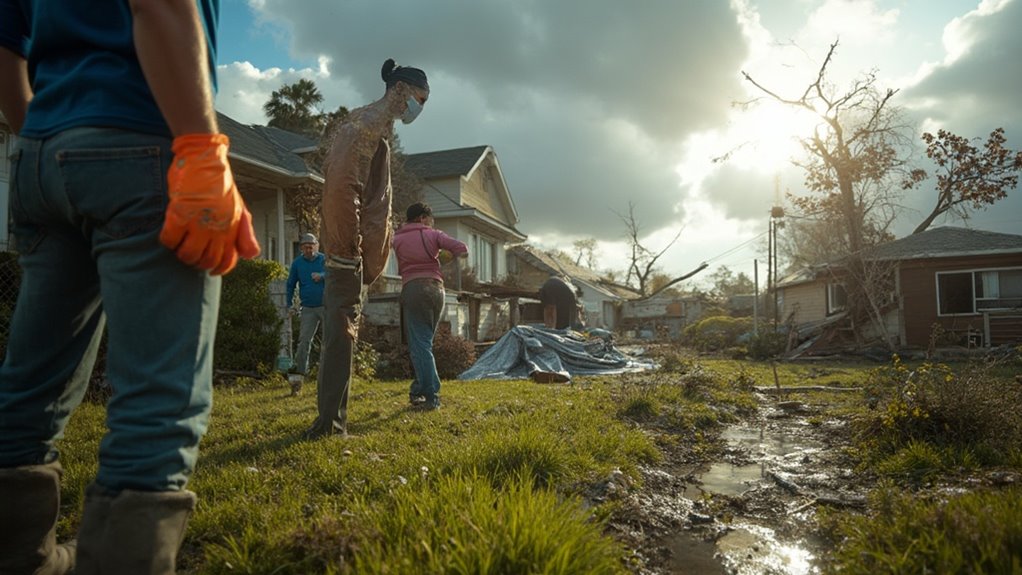
In the aftermath of a storm, safeguarding your property is imperative to prevent further damage and confirm safety. Start by addressing immediate property security concerns. Cover broken windows and doors with sturdy materials to block wind and water intrusion. If your roof's compromised, place a tarp over it to avert leaks and extra structural harm. Clearing debris from your yard, roof, and gutters is critical; this prevents water blockage and reduces the risk of mold growth.
Next, conduct a thorough inspection of your property. Document visible damage—photograph missing shingles, cracks, or water stains for insurance purposes. Be mindful of hazardous situations, such as downed power lines and sharp objects, which could pose risks during your assessment.
Don't forget to secure valuable items at risk of further damage. Move them to a safe location and confirm outdoor furniture or equipment won't become dangerous projectiles in strong winds. Moreover, check that your gutters and drains are clear to promote proper water flow away from your foundation. These proactive steps are significant for effective storm preparedness, helping you maintain property integrity and personal safety.
Engage Professional Help
Storm damage can leave you feeling overwhelmed, and seeking professional help is vital for a thorough recovery. Engaging licensed contractors not only guarantees your property is assessed accurately but additionally prepares you for the complexities ahead. Consider these key points:
- Professionals can identify hidden damage that might not be visible.
- Licensed contractors provide documented evaluations for insurance claims.
- They offer specialized services such as emergency roof tarping and water damage restoration.
- Experienced contractors know how to navigate the insurance claims process effectively.
When selecting the right professionals, prioritize contractor qualifications. Look for companies with 24/7 emergency service and a proven track record in storm recovery. Their expertise in structural integrity and system evaluations will guide your repair efforts efficiently. Confirm that they possess good customer reviews and a network of disaster recovery resources.
Investing time in choosing the right help now can prevent deeper issues later and improve your emergency preparedness for future storms. By leaning on their skills and knowledge, you'll not only restore your property but also advocate for fair compensation from your insurance company.
Communicate With Neighbors
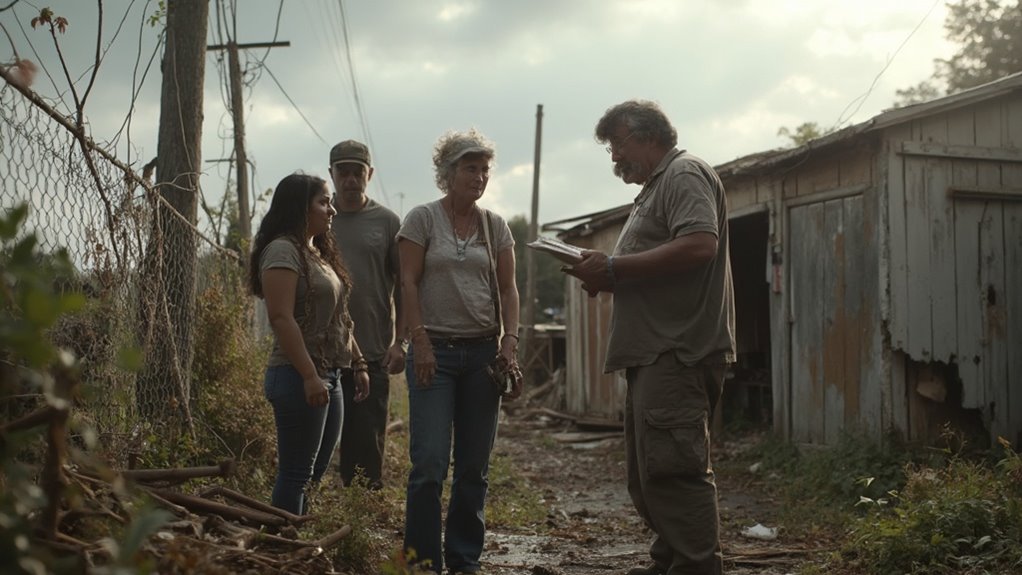
Effective communication with your neighbors is vital in the aftermath of storm damage. Start by using platforms like Nextdoor to share real-time updates on evacuation orders, flooding, and storm damage. These neighborhood communication channels help guarantee everyone stays informed. Text messages and social media can likewise serve as reliable alternatives to phone calls, providing immediate access to critical information.
Coordinate recovery efforts by asking neighbors to send photos of your property for insurance claims if you're not there. Inform them about local shelters, food pantries, and emergency resources. Sharing links to evacuation routes and crucial supplies can improve community preparedness.
Don't forget to check on vulnerable neighbors, especially the elderly or disabled. They may need assistance with debris removal or accessing vital services. A simple visit or phone call can provide emotional support and reassurance during a stressful time.
Lastly, consider building a community contact list to keep everyone connected. Create a neighborhood Facebook page or text group to streamline communication and report emergencies. By nurturing a spirit of collaboration, you can help your neighborhood recover more efficiently and effectively.
Monitor for Additional Risks
After a storm passes, it's crucial to monitor for additional risks that could jeopardize your safety and property. Conducting a thorough risk assessment and hazard identification will help you spot potential dangers before they escalate. Here's what to focus on:
- Structural Hazards: Inspect your roof for missing shingles and check for cracks on exterior walls. Look for fallen trees that may have struck your home.
- Electrical and HVAC Systems: Confirm all electrical components are safe to use. Verify that your heating and cooling systems are dry and functioning correctly.
- Water Intrusion: Examine areas around windows and ceilings for leaks. Clear gutters and downspouts to prevent further water damage.
- Environmental Hazards: Stay clear of downed power lines and sharp debris. Inspect your yard for damaged trees and clear any hazardous materials.
Review and Update Insurance Policy
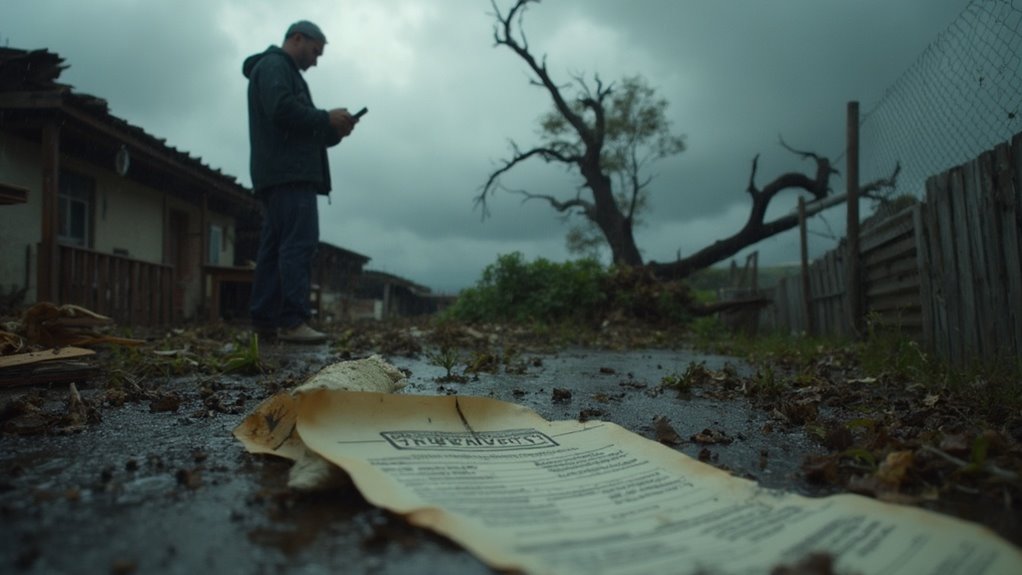
Maneuvering through the aftermath of a storm can be overwhelming, but reviewing and updating your insurance policy is a crucial step to guarantee your financial protection. Start by evaluating your current coverage against the types of storm damage typically covered, such as wind, hail, and sudden water pipe breaks. Remember, standard policies often exclude flood and earthquake damage, so you might need additional coverage for those risks.
Next, carefully review coverage limits and deductibles. Understand how these factors might impact your claims, especially if you're considering filing multiple claims because of extensive damage. It's likewise wise to document all storm damage thoroughly—take photos, save receipts, and maintain a log of communications with your insurer.
Stay informed about any recent legal changes affecting storm damage claims that could influence your policy terms. If you're uncertain about your coverage specifics, consulting with an insurance expert can provide clarity. Making timely insurance policy updates not only safeguards your finances but also empowers you to navigate the claims process with confidence, ensuring you're prepared for future storms.
Conclusion
In the wake of storm damage, you've navigated a turbulent sea of challenges. As you begin to mend your property, remember that every small step toward restoration is a brushstroke on the canvas of recovery. Welcome the journey with patience and resilience, knowing that brighter days lie ahead. By taking proactive measures now, you're not just repairing structures; you're nurturing the heart of your home, transforming scars into stories of strength and renewal.



